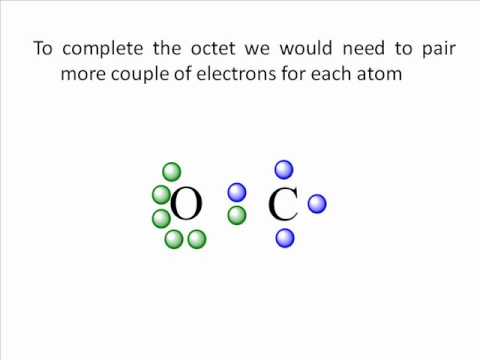

If the atom brought four electrons of its own and it is now sharing eight, things are even.

What we are really doing when we assign formal charge is comparing how many electrons the atom brought with it from the periodic table to how many it has now. These charges cancel to give an overall neutral molecule.
#Co carbon monoxide lewis structure plus
Oxygen has a plus charge and carbon has a minus charge. Notice that overall the carbon monoxide molecule is neutral. Carbon has a negative formal charge and oxygen has a positive formal charge. Structural formula of carbon monoxide with three bonds and one lone pair on both carbon and oxygen. How did it get an octet with only three bonds? It got an extra electron from somewhere (the oxygen). Diagram of how each bond in carbon monoxide is like oxygen keeping one electron of a lone pair and donating one electron to carbon.Ĭarbon has normal valence four, but here it is only making three bonds, even though it has an octet. Since it gives one of its electrons to carbon, it has formal charge +1. If it is sharing a pair of electrons, we can think of it keeping one for itself and giving the other to carbon. It is sharing an extra pair of its electrons with carbon to make that third bond. Oxygen has normal valence two, but here it is making three bonds. With ten electrons total, the only way to get an octet on both atoms is to make three bonds between carbon and oxygen. There are no formal charges on the hydrogens either.Ĭarbon monoxide has a structure that is very similar to formaldehyde. Carbon has a normal valence of four, and it has four bonds here. Oxygen has a normal valence of two, and it has two bonds in formaldehyde, so there is no formal charge on the oxygen. Calcium carbonate is found in limestone and chalk, for instance. Carbonate is an anion that is found in many forms. Carbon monoxide results from burning fossil fuels it is also an important industrial chemical used in manufacturing detergents. Formaldehyde (CH 2O) is a chemical that is used to preserve tissues you may be familiar with its odour from anatomy lab. To help us think about formal charges, let's look at a few small molecules that all contain carbon-oxygen multiple bonds but that are slightly different from each other. valence rules can act as flags to alert you that formal charges are present.formal charge is often present if the atom does not have its usual number of bonds.If an atom donates fewer electrons than normal and everyone still has an octet, it must be getting extra electrons from somewhere else. If an atom needs to donate more electrons than normal in order for everyone to get an octet, it will have a positive formal charge. They tell us if one atom is donating extra electrons to another to give it an octet. You will see why below.įormal charges are an important book-keeping device that we use in Lewis structures. In a Lewis structure of the compound, the carbon has a formal negative charge. However, the fact that the carbon is attracted to a metal cation begs the question: Is the carbon an anion? Yes, in a sense. Why does the molecule behave in this way? There are actually a number of reasons. atoms with negative formal charges often donate electrons.atoms with positive formal charges often attract electrons.formal charge can help us predict how a molecule behaves.

In the case of hemoglobin, because the carbon monoxide binds very strongly to the iron, the CO blocks the position where oxygen would normally be bound and carbon monoxide poisoning results. When exposed to transition metal cations such as the iron in hemoglobin (Fe2+), the carbon is attracted to and binds to the metal.


 0 kommentar(er)
0 kommentar(er)
